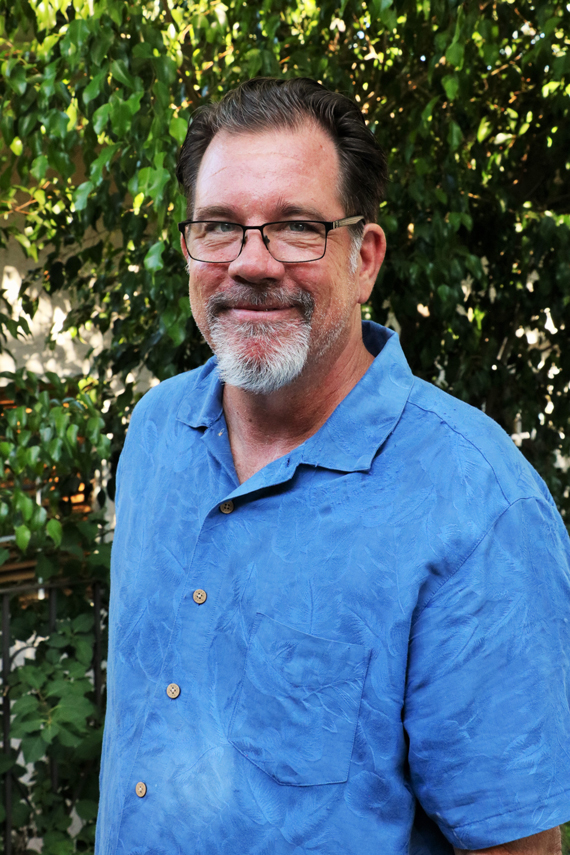|
Parish Rye Interview, 2019
By Alana Coons
 |
Is your plant survey the only survey of Presidio Park's horticulture?
This is the first survey of the park in about 50 years, and for the first time, this project has brought together into one place all three major plant surveys of Presidio Park. First, in 1937, Percy Broell, park superintendent under George Marston, the self-described "man-on-the-ground", second, Chauncy Jerabek, the 1960s and '70s "Tree Man of Balboa Park" who documented the horticulture of the park in the form of a plant walk during the late 1960s, and then my project.
What did you personally find most surprising or exciting or important about this work?
I became an accidental "expert" of Presidio Park plants as I was originally just trying to make maps as well as bring more people into the park. I wanted more people from the neighborhood to enjoy the park. It had a reputation as a place of crime, strange people and homelessness, which was scaring away the general public. But the making of the maps was my primary interest early on. The plants were initially just the data I needed to make the maps. But as I began to learn about the plants, my interests evolved. I was interested in the historical perspective—where did they come from, and who were the people who had "discovered" them, and what is the history of their Latin names. Very few botanical books combine all of that. After all, I studied geography, and I have always been interested in the who, what, where, how, and why of any particular location. I really enjoyed learning about each plant's "location of origin" as I termed it. This progressed into an interest about why each of the plants was there. I learned that there was a 1937 survey and a 1969 survey, but I also learned that there were many plants that were planted in the 1970s, 1980s and 1990s as part of volunteer projects, or even as memorial plantings. A handful of trees had memorial plaques from the 70s and 80s. There were strange aloes that didn't seem to belong, one was so rare that it's seldom found in the United States. And odd, rare young eucalyptus trees (25+ years old), which also seemed to not fit, as if someone had decided on a whim a few decades ago to see if they'd grow there. I found cacti that were seemingly thrown randomly into their current positions. I even learned of a police officer who had planted a tree when he was a maintenance worker. It's still there.
Equally important, if not more so, was the Broell find. I was in the SDHC [San Diego History Center] library looking for Presidio horticulture documentation, and one of the librarians mentioned a box she knew of that had some seldom seen or used documents. That was back in 2008 or 2009, I think. But I'm not totally certain. She pulled the box out and there was the unpublished Broell document where I found his 1937 maps and all of his thoughts on the park and on Marston, including other documents. For me, it was like finding a treasure. I don't recall any other sources mentioning, let alone giving credit to Percy Broell for his work in Presidio Park other than in 2012, Myra Herrmann did credit him. But other than that, I think that's it. He deserves a lot more credit than what he has received. I have often wondered if he has descendants who would be interested to know how important he was to Presidio Park.
Once you became interested in this idea what took place?
I realized within a couple of weeks that this project had the potential to be massive. I decided very quickly that if I was going to start this plant ID, I was going to have to finish it. So, after a few weeks of skepticism—I was "all in." This was not the sort of thing that could be done halfway. Admittedly, the first few weeks, I was overwhelmed and really didn't know if we could do it. Quickly, I felt it was going to be a big project and would take a lot of time, which meant I had to keep the rotating people who were involved through the years (master gardeners, graduate students, volunteers, bosses) motivated and interested. Everything I encountered through my research along the way that was not directly related to the immediate survey at hand was simply an added bonus. All the historical maps and documents from Broell to Jerabek was information that, as I came across it, I knew it must be included into my report not only to provide a historical context, but also to add validity to my project. So the project continuously grew bigger and bigger.
The truth is—this was a huge undertaking. Every step of this project was self-motivated. Except for step one, when the then senior ranger of Balboa Park and Presidio Park, Casey Smith, informed me that a group from the Mission Hills Garden Club and some members of the Master Gardeners wanted to do a plant ID in Presidio. Casey told me to "go meet them and see what you can do." From that point on, there was no supervision. No deadlines. No directions. Just my own motivation saying, "You better figure this out."
The best advice I got for this project had nothing to do with the project itself and was shared with me several years before we started the project. Park Ranger Kim Duclo told me once that "it isn't always that we (rangers) necessarily can actually fix every issue we come across, but so much of what we do is knowing the right people who can, and how to contact them." (paraphrased).
That was my motto through the whole process. If I didn't know something—and there was lots of that—I asked myself, "Who does, and where do I find them?"
What difficulties did you run across in your research and overall survey work?
Honestly, it was a constant moving ball. Nothing seemed to go as I planned, and everything had to be readjusted and tweaked, and then re-worked, re-scheduled, and then tried again. I was always learning something new—figuring out this or figuring out that. It was great. I loved it. My only goal was to keep moving forward: always make progress. I'm not a big fan of stagnation.
The most challenging part for me was not the identifying of the plants or collecting the data in the field, but was rather working with the ESRI ArcMap software and the importation of the field data into the software at the office. I am so grateful to have had the help of city employee Jason Allen, former open space senior park ranger, now biologist II, who was well versed in the software and was always willing to take my call and walk me through some of the technical issues, over and over. He was very patient with me and my never-ending questions.
The photo essay part of the project was almost as challenging as the GPSing of the plants. I found myself going back repeatedly to the same plants over and over during the course of several years in order to capture photos of the blooms or the fruit of the 207 species. I'm grateful to Carol Jean Wolcott for helping me realize how important it was to get those photographs.
Could you describe the research a bit, anecdotes about the fieldwork, for instance?
The actual process of the field work I enjoyed. I loved being outside. The reality of collecting the data with the GPS handheld unit or taking the pictures was never something I could plan. Working on this project was always secondary to my other responsibilities. I bounced back and forth between Balboa Park and Presidio Park. I wasn't necessarily able to focus exclusively on the project for any length of time. I led tours in both parks, conducted volunteer projects, assisted in emergency situations and performed law enforcement as required, and whatever else came up. It was pretty normal for me to make a law enforcement contact in Presidio and, while doing so, notice a flower in the distance out of the corner of my eye, blowing in the wind, that I knew I needed for the project, and, then after the contact was over, I would go over and snap that photo. Or conversely, be standing on a hill, let's say collecting data on a Torrey Pine, only to hear a commotion in the bushes that needed to be investigated.
What specific directions do you think this research might or should go from here? What potential applications might this research hold now and for the future?
Because all three projects are now combined for the first time, one can easily determine what Marston intended, Jerabek saw, and I documented—for the purpose of preserving San Diego's history.
My project is like a historical horticultural snapshot in time. I definitely do not want the content to be open source, any more than a book written in 1757 that describes the flora and fauna on a distant island should be edited to reflect what exists there now. However, I think technically, the GIS data could be copied and utilized in a separate project—unrelated if you will. From my data, an app could be created. People could walk around the park learning about the plants. But I personally don't know how to do that.
Is there anything else you would like to say? Are there any questions you would like to answer that I didn't ask?
Yes. As I neared the end of the project, after I had brought together Percy Broell's 1937 maps and legends, Chauncy Jerabek's 1960s plant walk, and my project all into one document, I understood that I had another problem: What good is all this, if the public doesn't know it exists and can't utilize it? I put significant effort into contacting people who I thought would be interested. And without fail, everyone who saw the project was impressed; without exception. All of the GIS data is in the possession of the City, but in spite of that, I was unable to get the project into the public's hands.
Long before I had even heard of SOHO, I thought of myself as a preservationist. What's gone, is gone. But places and things with historical significance should be preserved so that they don't disappear, too.
That is why I am so humbled and grateful for Save Our Heritage Organisation (SOHO). Because of SOHO's vision and dedication, this work can now be shared with the citizens of San Diego and the people of the world as a historical document, a horticultural resource, and a strong foundation for Presidio Park's cultural landscape designation in the future. Thank you, SOHO.
See the 2018 Parish Rye Maps HERE
See the 2018 Genus and Species Inventory HERE
See the Project History HERE
|
|

